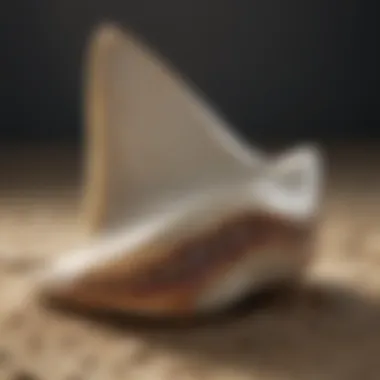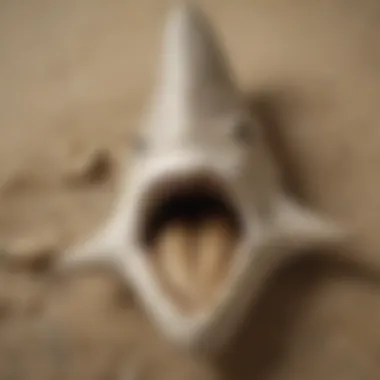Unraveling the Enigmatic White Shark Tooth: Anatomy, Significance, and Ecosystem Role


Rock and Fossil Identification
Exploring the enigmatic world of the white shark tooth opens up a realm of understanding that delves deep into the essence of this iconic predator's weaponry. Within the realm of rock and fossil identification lies a treasure trove of knowledge waiting to be unearthed. Types of rocks and fossils that encapsulate the origins and formation of these awe-inspiring teeth range from sedimentary rocks to fossilized remains of ancient marine creatures. Characteristics to look for include the unique serrations, size, and overall structure that distinguish white shark teeth from other species.
Moving beyond surface-level observation, the tools required for accurate identification are crucial. Magnifying glasses offer a close-up view of the intricate details etched into every tooth, revealing the evolutionary path these predators have undergone. Utilizing measuring devices allows for precise measurements, aiding in categorizing these remarkable fossils based on established scientific parameters.
Collecting Tips and Techniques
Embarking on a journey to collect white shark teeth necessitates strategic planning and a keen eye for detail. Best practices include researching prime collecting sites where these teeth are prevalent, such as near coastal areas or in fossil-rich sediment layers. Locating these prime spots requires an understanding of the geological formations that are conducive to preserving these treasures.
To safely extract specimens, tools such as fine-toothed tweezers help in delicately removing teeth from sediment without causing damage. Brushing techniques using soft bristles aid in clearing away excess debris while preserving the integrity of the tooth. The delicate process of extraction requires patience and precision to ensure each tooth is retrieved intact.
Preservation and Display
Preserving the pristine condition of white shark teeth is essential to conserving their inherent beauty and historical significance. Utilizing proven techniques like cleaning with mild detergents and avoiding harsh chemicals ensures the longevity of these fossils. Proper storage methods involve keeping teeth in a dry environment to prevent degradation and preserving them in protective cases to prevent physical damage.
Creative display ideas showcase these marvels of nature in ways that captivate the imagination. Whether arranging teeth in a chronological display to depict the evolutionary journey of these predators or incorporating them into jewelry pieces for personal adornment, the possibilities for displaying these fossils are as vast as the ocean itself.
Geological Insights
Diving into the geological insights surrounding white shark teeth unveils a narrative intertwined with the Earth's history. Geological formations and processes that have shaped these teeth over millennia offer a glimpse into the dynamic environmental changes that have occurred. The historical significance of these teeth lies in their role as key indicators of past marine ecosystems and the predatory behavior of these apex predators.
Exploring notable discoveries in the field sheds light on breakthroughs that have revolutionized our understanding of white shark teeth. Unearthing fossils in unexpected locations or uncovering teeth with rare characteristics sparks new avenues of research and fuels the passion of collectors and scientists alike. Each discovery adds a piece to the puzzle of understanding these majestic creatures and their enduring legacy in the annals of deep-sea exploration.
Introduction
In the vast expanse of the marine world, the white shark tooth stands as a symbol of ancient power and evolutionary prowess. This article embarks on a journey to unveil the mysteries enshrined within the anatomy and significance of the white shark tooth. From the jagged serrated edges to the intriguing adaptations for predation, each facet of this tooth tells a tale of survival and dominance in the oceanic realm. As we dive deeper into the heart of this enigma, we discover not just a tooth but a key to understanding the ecological dynamics of marine ecosystems.
Exploring the White Shark Tooth
An Overview of Shark Teeth
The genesis of fascination with shark teeth lies in the sheer diversity and uniqueness of these biological structures. From the formidable jaws of the great white to the delicate rows of a nurse shark, each tooth type speaks volumes about its owner's feeding habits and ecological niche. The overarching significance of these teeth transcends mere utility; they are windows into the evolutionary past of one of nature's most efficient predators. The standardized shape, size, and function of shark teeth are vital aspects that play a crucial role in defining shark species and their hunting strategies. Studying the intricacies of shark teeth allows us to decipher the evolutionary paths taken by these majestic creatures, offering valuable insights into their behavioral ecology and survival tactics.
The Significance of White Shark Teeth


Among the myriad varieties of shark teeth, the white shark tooth holds a special place due to its evolutionary refinement and deadly efficiency. The anatomy of the white shark tooth is a marvel of nature, with razor-sharp serrated edges designed for tearing through flesh with precision and ease. These teeth not only serve as tools for predation but also as indicators of the white shark's place atop the oceanic food chain. The distinctive features of white shark teeth, such as their robust root and formidable crown, embody millions of years of evolutionary fine-tuning for unmatched hunting prowess. Understanding the significance of white shark teeth goes beyond mere admiration; it offers a glimpse into the dynamic interplay between predator and prey in the underwater realm, showcasing nature's ingenuity in equipping its creatures for survival.
Anatomy of the White Shark Tooth
In this section, we will delve into the intricate details of the Anatomy of the White Shark Tooth, shedding light on why this topic is pivotal in unraveling the mysteries of these apex predators. The anatomy of the white shark tooth plays a crucial role in understanding the predatory nature and evolutionary adaptations of these majestic creatures. By examining the structure and composition of shark teeth, we can gain profound insights into their hunting techniques, ecological significance, and evolutionary history.
Structure and Composition
Serrated Edges
The Serrated Edges of white shark teeth are a defining feature that sets them apart from other species. These razor-sharp edges are finely serrated, creating a saw-like appearance that aids in gripping and tearing prey more efficiently. The serrations increase the cutting efficiency of the tooth, allowing for precise and quick consumption of prey. In this article, we will explore how these serrated edges enhance the white shark's predatory abilities and contribute to its role as a top marine predator. Understanding the intricate details of serrated edges provides valuable insights into the hunting behavior and feeding ecology of white sharks.
Root and Crown
The Root and Crown structure of white shark teeth is essential in understanding their durability and functionality. The robust root anchoring the tooth in the jaw enables white sharks to exert immense biting forces without the risk of losing their teeth during hunting activities. The crown, which is responsible for cutting and slicing through thick prey items, showcases a balance between hardness and sharpness. We will discuss how this unique root and crown structure contributes to the white shark's predatory success and longevity. By examining the root and crown features in detail, we can appreciate the evolutionary adaptations that have shaped the white shark tooth into a formidable tool for predation.
Adaptations for Predation
Regeneration Mechanisms
White shark teeth exhibit remarkable Regeneration Mechanisms that set them apart from other toothed species. The ability of white sharks to replace lost or damaged teeth continuously ensures a consistent supply of functional teeth for hunting and feeding. This section will explore how regeneration mechanisms play a vital role in maintaining the white shark's dental health and predatory prowess. By illuminating the mechanisms behind tooth regeneration, we can glean insights into the adaptability and resilience of these fascinating marine predators.
Efficiency in Hunting
The Efficiency in Hunting displayed by white sharks is closely linked to their unique tooth structures and feeding behavior. White shark teeth are finely tuned for capturing and consuming a wide array of prey items with maximum efficiency. Their teeth are designed to deliver swift and lethal bites, minimizing energy expenditure during hunting pursuits. We will uncover how the efficiency in hunting, aided by the specialized tooth morphology of white sharks, contributes to their success as top-level predators in ocean ecosystems. By examining the adaptive advantages of efficient hunting techniques, we can appreciate the strategic prowess of white sharks in securing their food sources.
Evolutionary Insights
In this article, delving into the mysteries of the white shark tooth requires a profound understanding of its evolutionary journey. Evolutionary insights offer a crucial lens through which we can comprehend the adaptive marvels of shark teeth over time. By examining the ancient origins of these formidable predators, we gain a deep appreciation for the intricate mechanisms that have allowed white shark teeth to persist as remarkable evolutionary masterpieces. Understanding the evolutionary trajectory of these teeth not only sheds light on their past but also provides valuable insights for future research endeavors. The evolutionary history of white shark teeth is a testament to the power of natural selection and the enduring legacy of shark species throughout the ages.
Ancient Origins
Adaptive Changes Over Time
Unraveling the saga of adaptive changes over time in the context of white shark teeth offers a captivating glimpse into the evolutionary forces at play. The process of adaptation has sculpted these teeth into finely tuned instruments of predation, honed by millennia of evolutionary refinement. Examining how white shark teeth have adapted to changing environments and prey preferences underscores the dynamic interplay between biological imperatives and ecological pressures. The resilience and versatility showcased by adaptive changes over time highlight the evolutionary prowess of white shark teeth, positioning them as formidable weapons in the evolutionary arms race. The noteworthy characteristic of adaptability showcased by these teeth underscores their significance in the larger narrative of evolutionary biology.
Fossil Records


Exploring the fossil records of white shark teeth unveils a treasure trove of information regarding their ancient lineage and evolutionary development. Fossils provide a tangible link to the past, offering snapshots of bygone eras and evolutionary milestones. By scrutinizing fossilized shark teeth, researchers can trace the morphological transformations these structures have undergone across geological time scales. The intricate details preserved in fossil records serve as invaluable resources for reconstructing the evolutionary history of white shark teeth. Analyzing the fossil evidence not only elucidates the evolutionary trajectories of these teeth but also allows for a deeper appreciation of the rich tapestry of life that has culminated in the iconic white shark tooth we recognize today.
Comparative Studies
Variations Among Shark Species
The comparative study of variations among shark species provides a nuanced perspective on the diversified landscape of shark teeth across different taxa. By examining the unique characteristics that define each species' dental morphology, researchers can unravel the intricate patterns of evolution that have shaped these diverse tooth structures. Comparing and contrasting the adaptations present in various shark species' teeth offers invaluable insights into the selective pressures that have steered their evolutionary courses. The exploration of variations among shark species underscores the remarkable diversity and plasticity inherent in shark teeth, showcasing the adaptive potential encoded within these evolutionary artifacts.
Ecological Implications
Investigating the ecological implications of white shark teeth sheds light on the broader ecological dynamics underpinning predator-prey interactions in marine ecosystems. The role played by these teeth in shaping predator-prey relationships underscores their pivotal position within the intricate web of marine life. By delving into the ecological ramifications of white shark teeth, researchers can elucidate the far-reaching consequences of apex predator behaviors on ecosystem stability. The unique features of white shark teeth, finely tuned through evolutionary processes, hold profound implications for ecosystem health and resilience, highlighting the interconnectedness of species within marine environments.
Ecological Role of White Shark Teeth
The Ecological Role of White Shark Teeth plays a pivotal role in maintaining the delicate balance of marine ecosystems. White shark teeth, known for their razor-sharp serrated edges, are essential tools for these apex predators in capturing and consuming prey. Understanding the ecological significance of these teeth sheds light on the interdependent relationships within oceanic food webs. From shaping predator-prey dynamics to influencing behavioral patterns, white shark teeth are intricately linked to the health and functioning of marine environments.
Predator-Prey Dynamics
Impact on Marine Ecosystems
Exploring the Impact on Marine Ecosystems reveals the crucial role that white shark teeth play in regulating and stabilizing aquatic habitats. By preying on various marine species, white sharks help control population sizes, thus preventing overgrazing of crucial marine vegetation. This predatory behavior ensures the biodiversity and sustainability of marine ecosystems. The unique design of white shark teeth enables efficient hunting, making them a formidable force in maintaining the balance of the oceanic food chain.
Behavioral Patterns
Analyzing Behavioral Patterns provides insights into the hunting strategies and social interactions of white sharks. These behavioral patterns, influenced by the presence and effectiveness of their teeth, dictate the feeding habits and territorial behaviors of these apex predators. Understanding the nuances of white shark behavior enhances our appreciation for their role in shaping marine ecosystems and highlights the intricacies of their predatory nature.
Symbolism and Cultural Significance
Mythological Representations
Delving into Mythological Representations unravels the symbolic meanings attributed to white shark teeth across different cultures and folklore. In various mythologies, white shark teeth symbolize strength, power, and dominance, often associated with stories of bravery and prowess. Exploring these mythological connections adds a layer of mystique to the enigmatic allure of white shark teeth and deepens our understanding of their cultural significance.
Modern Interpretations
Modern Interpretations reflect contemporary perspectives on white shark teeth, considering their ecological importance and conservation challenges. In today's society, white shark teeth symbolize resilience and adaptation in the face of environmental threats, serving as a reminder of the delicate balance between human activities and natural ecosystems. Investigating these modern interpretations provides insights into current conservation efforts and ethical considerations surrounding the preservation of these iconic marine predators.
Conservation Efforts and Ethical Considerations


Conservation efforts and ethical considerations surrounding the white shark tooth serve as a crucial aspect of this article, shedding light on the preservation of marine ecosystems and the ethical implications of shark tooth collection. By delving into these topics, we aim to underline the significance of sustainable practices in protecting these iconic predators and maintaining ecological balance.
Regulations on Shark Tooth Collection
Legal Frameworks
Legal frameworks play a vital role in governing the collection and trade of shark teeth, ensuring compliance with laws and regulations to prevent overexploitation of marine resources. These frameworks establish guidelines for sustainable harvesting practices, setting limits on the extraction of shark teeth to safeguard wild populations and promote responsible use of natural resources. The incorporation of legal frameworks in this article highlights the necessity of structured governance in conservation efforts and emphasizes the enforceable rules that contribute to the protection of shark species and their habitats.
Sustainable Practices
Emphasizing sustainable practices in shark tooth collection underscores the importance of environmentally friendly strategies that prioritize long-term conservation goals. By promoting sustainable harvesting methods and encouraging ethical sourcing of shark teeth, this article advocates for the adoption of practices that minimize environmental impact and support biodiversity conservation. Sustainable practices not only protect the white shark population but also uphold ethical standards in the procurement of shark teeth, aligning with the broader goal of fostering a sustainable relationship between humans and marine ecosystems.
Ethical Dilemmas
Amidst the conservation discourse lies ethical dilemmas inherent to shark tooth collection, prompting reflections on the ethical complexities surrounding the commercial trade of shark teeth. Through the exploration of ethical considerations, this article navigates the delicate balance between commercial interests and environmental stewardship, highlighting the moral quandaries associated with the exploitation of shark populations for economic gain. By addressing these dilemmas, we offer insight into the ethical dimensions of shark tooth collection and encourage readers to carefully consider the implications of their actions on marine biodiversity and ecosystem health.
Commercial Exploitation
Commercial exploitation of shark teeth raises ethical concerns regarding the sustainability of harvesting practices and the impact on shark populations. Tracing the implications of commercial exploitation, this section explores the consequences of unchecked extraction on marine ecosystems and advocates for responsible management practices that prioritize conservation over profit. By scrutinizing the ethical implications of commercial exploitation, we seek to prompt discussions on the ethical responsibilities of individuals and industries engaged in shark tooth collection to mitigate adverse effects on marine environments.
Preservation Strategies
Navigating the realm of preservation strategies unveils alternative approaches to conservation that prioritize the protection of shark species and their habitats. By analyzing preservation strategies, this article underscores innovative methodologies aimed at safeguarding shark populations and promoting biodiversity conservation. The discussion on preservation strategies delves into proactive measures to mitigate the negative impacts of shark tooth collection, advocating for the implementation of comprehensive plans that integrate conservation objectives with ethical considerations. Through a critical evaluation of preservation strategies, readers can gain insights into sustainable practices that contribute to the longevity of shark populations and marine ecosystems.
Conclusion
In this concluding passage, we encapsulate the essence of our exploration into the enigmatic white shark tooth, underscoring the vital role it plays in the delicate balance of ecosystems. By synthesizing the information presented throughout the article, we aim to inspire a deep-seated appreciation for the beauty and functionality of nature's designs. Furthermore, we shed light on the ethical implications of human interactions with these apex predators and advocate for sustainable practices that ensure the continuity of marine biodiversity.
This conclusive section leaves readers with a profound sense of wonder and responsibility, urging them to reflect on the marvels of the natural world and consider their impact on the environment. It serves as a call to action, prompting further research, discussions, and actions to safeguard these fascinating creatures for generations to come.
Unveiling the Enigmatic White Shark Tooth
Reflecting on Nature's Wonders
Reflecting on Nature's Wonders within the context of the white shark tooth unveils a tapestry of marvels that underscore the intrinsic beauty and functionality of this ocean predator's anatomy. The serrated edges, often seen as symbols of fear, actually serve a profound purpose in the shark's ability to hunt and survive in its habitat. The evolution of these razor-sharp teeth over millennia signifies nature's intricate design and adaptation to changing environments, a testament to the relentless force of evolution.
In this article, Reflecting on Nature's Wonders illuminates the exquisite balance of form and function exhibited by the white shark tooth, showcasing how even the smallest details contribute to the success of apex predators in the oceans. The unique feature of these teeth lies in their regenerative capabilities, allowing sharks to constantly renew their hunting tools and maintain peak efficiency in capturing prey. This adaptive trait not only highlights the resilience of these creatures but also underscores the need for conservation efforts to preserve such specialized adaptations within ecosystems.
Inspiration for Future Research
The section focusing on Inspiration for Future Research offers a compelling glimpse into the endless possibilities that the study of white shark teeth presents to scientists and researchers. By delving into the evolutionary history, genetic markers, and ecological interactions of these teeth, scholars can unlock a treasure trove of knowledge that extends far beyond the realms of marine biology. By exploring the implications of white shark tooth adaptations on other species and ecosystems, researchers can garner insights that inform conservation strategies and management policies.
In this article, Inspiration for Future Research sparks a sense of curiosity and exploration, urging readers to consider the vast potential for discovery and innovation inherent in the study of the white shark tooth. The distinctive feature of this research lies in its interdisciplinary nature, bridging gaps between biology, paleontology, and conservation science to provide a holistic understanding of the role these teeth play in shaping marine environments. By embracing the challenges and opportunities presented by studying the white shark tooth, future research endeavors can spearhead conservation initiatives that protect not only these iconic predators but also the delicate web of life they inhabit.







